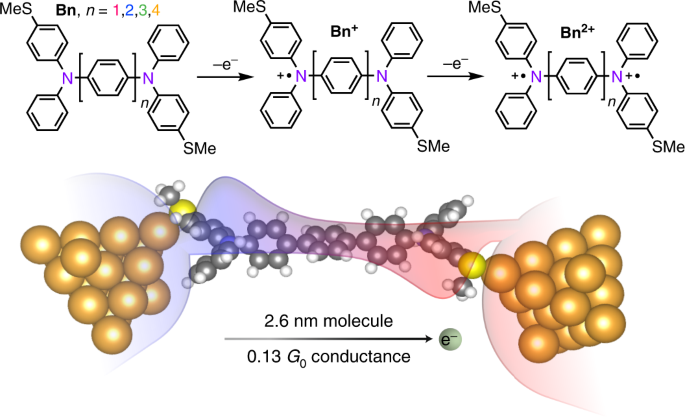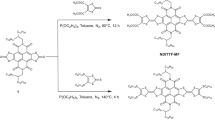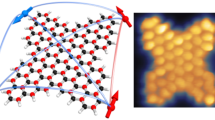Abstract
Single-molecule topological insulators are promising candidates as conducting wires over nanometre length scales. A key advantage is their ability to exhibit quasi-metallic transport, in contrast to conjugated molecular wires which typically exhibit a low conductance that decays as the wire length increases. Here, we study a family of oligophenylene-bridged bis(triarylamines) with tunable and stable mono- or di-radicaloid character. These wires can undergo one- and two-electron chemical oxidations to the corresponding mono-cation and di-cation, respectively. We show that the oxidized wires exhibit reversed conductance decay with increasing length, consistent with the expectation for Su–Schrieffer–Heeger-type one-dimensional topological insulators. The 2.6-nm-long di-cation reported here displays a conductance greater than 0.1G0, where G0 is the conductance quantum, a factor of 5,400 greater than the neutral form. The observed conductance–length relationship is similar between the mono-cation and di-cation series. Density functional theory calculations elucidate how the frontier orbitals and delocalization of radicals facilitate the observed non-classical quasi-metallic behaviour.

This is a preview of subscription content, access via your institution
Access options
Access Nature and 54 other Nature Portfolio journals
Get Nature+, our best-value online-access subscription
$29.99 / 30 days
cancel any time
Subscribe to this journal
Receive 12 print issues and online access
$259.00 per year
only $21.58 per issue
Buy this article
- Purchase on Springer Link
- Instant access to full article PDF
Prices may be subject to local taxes which are calculated during checkout




Similar content being viewed by others
Data availability
The data that support the findings of this study are available only on request from the corresponding authors. Prior to making the data available, the data need to be converted from a binary format to a text format, which we are happy to do on request.
Code availability
The data that support the findings were acquired using a custom instrument controlled by custom software (Igor Pro, Wavemetrics). The software is available from the corresponding authors upon reasonable request.
References
Davis, W. B., Svec, W. A., Ratner, M. A. & Wasielewski, M. R. Molecular-wire behaviour in p-phenylenevinylene oligomers. Nature 396, 60–63 (1998).
Nitzan, A. & Ratner, M. A. Electron transport in molecular wire junctions. Science 300, 1384–1389 (2003).
Choi, S. H., Kim, B. & Frisbie, C. D. Electrical resistance of long conjugated molecular wires. Science 320, 1482–1486 (2008).
Lafferentz, L. et al. Conductance of a single conjugated polymer as a continuous function of its length. Science 323, 1193–1197 (2009).
Sedghi, G. et al. Long-range electron tunnelling in oligo-porphyrin molecular wires. Nat. Nano. 6, 517–523 (2011).
Nacci, C. et al. Conductance of a single flexible molecular wire composed of alternating donor and acceptor units. Nat. Commun. 6, 7397 (2015).
Zhou, Y. et al. Quantum length dependence of conductance in oligomers: first-principles calculations. Phys. Rev. B 75, 245407 (2007).
Reimers, J. & Hush, N. Electron transfer and energy transfer through bridged systems. I. Formalism. Chem. Phys. 134, 323–354 (1989).
Joachim, C. Ligand-length dependence of the intramolecular electron transfer through-bond coupling parameter. Chem. Phys. 116, 339–349 (1987).
Tsuji, Y., Movassagh, R., Datta, S. & Hoffmann, R. Exponential attenuation of through-bond transmission in a polyene: theory and potential realizations. ACS Nano 9, 11109–11120 (2015).
Li, S., Gan, C. K., Son, Y.-W., Feng, Y. P. & Quek, S. Y. Anomalous length-independent frontier resonant transmission peaks in armchair graphene nanoribbon molecular wires. Carbon 76, 285–291 (2014).
Gil-Guerrero, S., Peña-Gallego, Á., Ramos-Berdullas, N., Martin Pendas, A. & Mandado, M. Assessing the reversed exponential decay of the electrical conductance in molecular wires: the undeniable effect of static electron correlation. Nano Lett. 19, 7394–7399 (2019).
Heeger, A. J., Kivelson, S., Schrieffer, J. & Su, W.-P. Solitons in conducting polymers. Rev. Mod. Phys. 60, 781–850 (1988).
Cirera, B. et al. Tailoring topological order and π-conjugation to engineer quasi-metallic polymers. Nat. Nano. 15, 437–443 (2020).
Su, W. P., Schrieffer, J. & Heeger, A. J. Solitons in polyacetylene. Phys. Rev. Lett. 42, 1698–1701 (1979).
Stuyver, T., Zeng, T., Tsuji, Y., Geerlings, P. & De Proft, F. Diradical character as a guiding principle for the insightful design of molecular nanowires with an increasing conductance with length. Nano Lett. 18, 7298–7304 (2018).
Hernangómez-Pérez, D., Gunasekaran, S., Venkataraman, L. & Evers, F. Solitonics with polyacetylenes. Nano Lett. 20, 2615–2619 (2020).
Gunasekaran, S. et al. Near length-independent conductance in polymethine molecular wires. Nano Lett. 18, 6387–6391 (2018).
Zang, Y. et al. Cumulene wires display increasing conductance with increasing length. Nano Lett. 20, 8415–8419 (2020).
Xu, W. et al. Unusual length dependence of the conductance in cumulene molecular wires. Angew. Chem. Int. Ed. 58, 8378–8382 (2019).
Leary, E. et al. Bias-driven conductance increase with length in porphyrin tapes. J. Am. Chem. Soc. 140, 12877–12883 (2018).
Meier, E. J., An, F. A. & Gadway, B. Observation of the topological soliton state in the Su–Schrieffer–Heeger model. Nat. Commun. 7, 13986 (2016).
Montgomery, L. K., Huffman, J. C., Jurczak, E. A. & Grendze, M. P. The molecular structures of Thiele’s and Chichibabin’s hydrocarbons. J. Am. Chem. Soc. 108, 6004–6011 (1986).
Su, Y. et al. Tuning ground states of bis(triarylamine) dications: from a closed‐shell singlet to a diradicaloid with an excited triplet state. Angew. Chem. Int. Ed. 126, 2901–2905 (2014).
Heeger, A. J. Semiconducting and metallic polymers: the fourth generation of polymeric materials (Nobel lecture). Angew. Chem. Int. Ed. 40, 2591–2611 (2001).
Joubert-Doriol, L. & Izmaylov, A. F. Molecular “topological insulators”: a case study of electron transfer in the bis(methylene) adamantyl carbocation. Chem. Comm. 53, 7365–7368 (2017).
Lambert, C. & Nöll, G. The class II/III transition in triarylamine redox systems. J. Am. Chem. Soc. 121, 8434–8442 (1999).
Low, P. J. et al. Crystal, molecular and electronic structure of N,N′‐diphenyl‐N,N′‐bis(2,4‐dimethylphenyl)‐(1,1′‐biphenyl)‐4,4′‐diamine and the corresponding radical cation. Chem. Eur. J. 10, 83–91 (2004).
Xu, B. & Tao, N. J. Measurement of single-molecule resistance by repeated formation of molecular junctions. Science 301, 1221–1223 (2003).
Venkataraman, L. et al. Single-molecule circuits with well-defined molecular conductance. Nano Lett. 6, 458–462 (2006).
Park, Y. S. et al. Frustrated rotations in single-molecule junctions. J. Am. Chem. Soc. 131, 10820–10821 (2009).
Zang, Y. et al. Electronically transparent Au–N bonds for molecular junctions. J. Am. Chem. Soc. 139, 14845–14848 (2017).
Low, J. Z. et al. The environment-dependent behavior of the Blatter radical at the metal–molecule interface. Nano Lett. 19, 2543–2548 (2019).
Lu, Q. et al. From tunneling to hopping: a comprehensive investigation of charge transport mechanism in molecular junctions based on oligo (p-phenylene ethynylene)s. ACS Nano 3, 3861–3868 (2009).
Fatemi, V., Kamenetska, M., Neaton, J. & Venkataraman, L. Environmental control of single-molecule junction transport. Nano Lett. 11, 1988–1992 (2011).
Choi, B. et al. Solvent-dependent conductance decay constants in single cluster junctions. Chem. Sci. 7, 2701–2705 (2016).
Capozzi, B. et al. Tunable charge transport in single-molecule junctions via electrolytic gating. Nano Lett. 14, 1400–1404 (2014).
Delaney, P., Nolan, M. & Greer, J. Symmetry, delocalization, and molecular conductance. J. Chem. Phys. 122, 044710 (2005).
Blum, V. et al. Ab initio molecular simulations with numeric atom-centered orbitals. Comp. Phys. Comm. 180, 2175–2196 (2009).
Arnold, A., Weigend, F. & Evers, F. Quantum chemistry calculations for molecules coupled to reservoirs: formalism, implementation, and application to benzenedithiol. J. Chem. Phys. 126, 174101 (2007).
Bagrets, A. Spin-polarized electron transport across metal–organic molecules: a density functional theory approach. J. Chem. Theory Comp. 9, 2801–2815 (2013).
Quek, S. Y. et al. Amine−gold linked single-molecule circuits: experiment and theory. Nano Lett. 7, 3477–3482 (2007).
Evers, F., Korytár, R., Tewari, S. & van Ruitenbeek, J. M. Advances and challenges in single-molecule electron transport. Rev. Mod. Phys. 92, 035001 (2020).
Klausen, R. S. et al. Evaluating atomic components in fluorene wires. Chem. Sci. 5, 1561–1564 (2014).
Yoshizawa, K. An orbital rule for electron transport in molecules. Acc. Chem. Res. 45, 1612–1621 (2012).
Garner, M. H., Bro-Jørgensen, W., Pedersen, P. D. & Solomon, G. C. Reverse bond-length alternation in cumulenes: candidates for increasing electronic transmission with length. J. Phys. Chem. C 122, 26777–26789 (2018).
Gil-Guerrero, S., Ramos-Berdullas, N., Pendás, Á. M., Francisco, E. & Mandado, M. Anti-ohmic single molecule electron transport: is it feasible? Nano. Adv. 1, 1901–1913 (2019).
Asmar, M. M., Sheehy, D. E. & Vekhter, I. Topological phases of topological-insulator thin films. Phys. Rev. B 97, 075419 (2018).
Brédas, J.-L., Chance, R. & Silbey, R. Comparative theoretical study of the doping of conjugated polymers: polarons in polyacetylene and polyparaphenylene. Phys. Rev. B 26, 5843–5854 (1982).
Madrid, P. B., Polgar, W. E., Toll, L. & Tanga, M. J. Synthesis and antitubercular activity of phenothiazines with reduced binding to dopamine and serotonin receptors. Bioorg. Med. Chem. Lett. 17, 3014–3017 (2007).
Perdew, J. P., Burke, K. & Ernzerhof, M. Generalized gradient approximation made simple. Phys. Rev. Lett. 77, 3865–3868 (1996).
Lenthe, E. V., Baerends, E.-J. & Snijders, J. G. Relativistic regular two‐component hamiltonians. J. Chem. Phys. 99, 4597–4610 (1993).
Wilhelm, J., Walz, M., Stendel, M., Bagrets, A. & Evers, F. Ab initio simulations of scanning-tunneling-microscope images with embedding techniques and application to C58-dimers on Au(111). Phys. Chem. Chem. Phys. 15, 6684–6690 (2013).
Balasubramani, S. G. et al. TURBOMOLE: modular program suite for ab initio quantum-chemical and condensed-matter simulations. J. Chem. Phys. 152, 184107 (2020).
Acknowledgements
This work was supported in part by the National Science Foundation under grant DMR-1807580. J.Z.L. thanks the A*STAR Graduate Academy in Singapore for a graduate fellowship. S.G. was supported by a National Science Foundation Graduate Research Fellowship under grant DGE-1644869. C.R.P. was supported by a National Defense Science and Engineering Graduate Fellowship. X.Y. and G.L. acknowledge the Analysis and Testing Center of Beijing Institute of Technology for characterization in NMR and high-resolution mass spectrometry. X.Y. acknowledges the Beijing Institute of Technology Research Fund Program for Young Scholars. G.L. thanks the Project of the Science Funds of Jiangxi Education Office (GJJ180629) and the Project of Jiangxi Science and Technology Normal University (2016XJZD009) for financial support. J.W. and F.E. thank M. Camarasa-Gomez for helpful discussions. J.W. and F.E. acknowledge the Gauss Centre for Supercomputing for providing computational resources on SuperMUC-NG at the Leibniz Supercomputing Centre under project ID pn72pa. The work in Regensburg was supported by the Deutsche Forschungsgemeinschaft (German Research Foundation) through project ID 314695032 (SFB 1277, subprojects A03 and B01).
Author information
Authors and Affiliations
Contributions
L.L. and J.Z.L. performed all scanning tunnelling microscopy measurements. J.W., L.L. and D.G. performed all DFT calculations. G.L., R.L.S., C.R.P. and X.Y. performed all the synthesis. L.L., J.Z.L, J.W., X.Y., F.E., L.M.C. and L.V. wrote the paper with contributions from all authors. L.V., X.Y., F.E. and L.M.C. oversaw the project.
Corresponding authors
Ethics declarations
Competing interests
The authors declare no competing interests.
Peer review
Peer review information
Nature Chemistry thanks Marcos Mandado and the other, anonymous, reviewer(s) for their contribution to the peer review of this work.
Additional information
Publisher’s note Springer Nature remains neutral with regard to jurisdictional claims in published maps and institutional affiliations.
Supplementary information
Supplementary Information
Supplementary Figs. 1–15, Tables 1 and 2 and Discussion.
Rights and permissions
About this article
Cite this article
Li, L., Low, J.Z., Wilhelm, J. et al. Highly conducting single-molecule topological insulators based on mono- and di-radical cations. Nat. Chem. 14, 1061–1067 (2022). https://doi.org/10.1038/s41557-022-00978-1
Received:
Accepted:
Published:
Issue Date:
DOI: https://doi.org/10.1038/s41557-022-00978-1
This article is cited by
-
Regulation of quantum spin conversions in a single molecular radical
Nature Nanotechnology (2024)
-
Organic radicals in single-molecule junctions
Science China Materials (2024)
-
Collection of unconventional transport phenomena: natural obstacle or vibrant guiding principle for the design of molecular junctions?
AAPPS Bulletin (2024)
-
Single-molecule photoelectron tunnelling spectroscopy
Nature Materials (2023)
-
A highly efficient open-shell singlet luminescent diradical with strong magnetoluminescence properties
Light: Science & Applications (2023)



